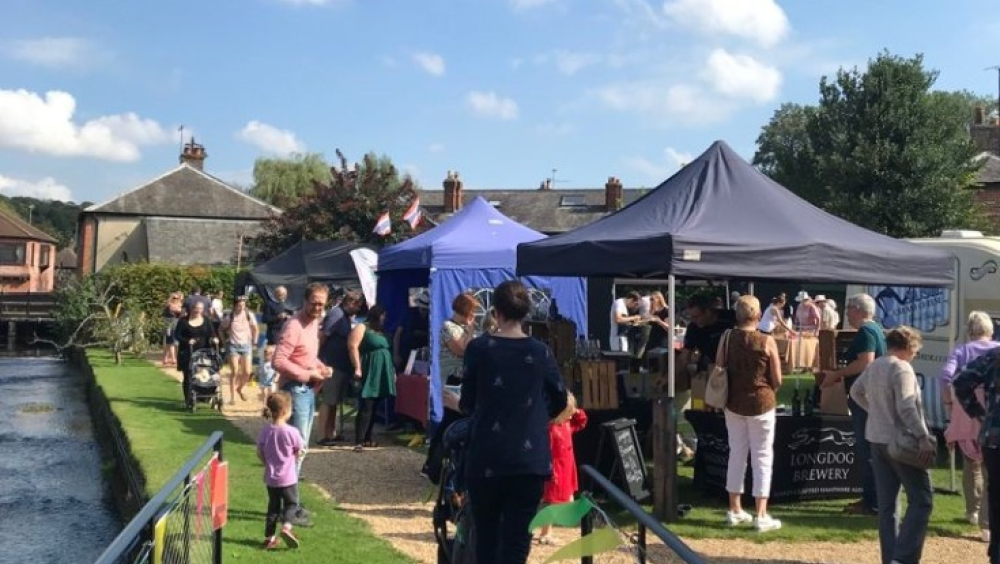Living, Weaving, Heritage at Whitchurch Silk Mill
Whitchurch Silk Mill has been home to silk production for over 200 years using traditional machinery and techniques. The Mill itself is located in a three-story Georgian building on the banks of the River Test. The 19th century waterwheel continues to turn and provide power to the winding machinery on the top floor. Often seen as a hidden gem in the small town of Whitchurch, Hampshire, the Mill has participated in Heritage Open Days for a number of years through working with Winchester heritage attractions. 2021 saw our first Heritage Open Days full site opening to the public with the launch of our Food Festival.
Whitchurch Silk Mill has been home to silk production for over 200 years using traditional machinery and techniques. Today we are passionate about keeping the skills and traditions alive and with thanks to the National Lottery Heritage Fund, a recent renovation project has rejuvenated the Mill as a working heritage site.
We offer a range of museum exhibitions, events and community engagement programmes, alongside our popular riverside café and shop. Key to the success of both delighting our visitors and continuing silk production, is our programme of placements and traineeships for weaving students. Overseen by our Senior Weaver, students get to experience all aspects of silk weaving. We are very pleased that our trainee successfully completed her initial year and has now taken up the position of weaver, ready to pass on her experience to the next group of students.
The Mill itself is located in a three-story Georgian building on the banks of the River Test. The 19th century waterwheel continues to turn and provide power to the winding machinery on the top floor. The complex work of creating a warp using the one-of-a-kind creel and warping mill takes place here, before being transferred to the looms in the ground floor weaving shed. To find out more about the history of the Mill, including video highlights, please visit our website – www.whitchurchsilkmill.org.uk.
Alongside woven pieces of fabric, one of our specialities to weave ribbons in the traditional way. The fabric is woven with two different coloured wefts, a recent example being one ‘Honey’ and the other ‘Alice Blue’. In the past clients have used our silk ribbons in historical tv and film costume production, including Back to the Future III, Titanic, and the BBC’s Death Comes to Pemberley. So it is worth looking out for our signature stripe when watching your next costume drama, you may well spot one of these lovely ribbons.
We weave our ribbons in what appears to be a full piece of fabric, so that the completed product, prior to cutting, looks like one big striped design. The distinguishing feature is the introduction of a leno or miniature selvedge, bordering the edge of each stripe. This allows us to cut between the two selvedges to create the ribbon stripes without it fraying. These ribbons are organzine warp and weft with a satin stripe.
Often seen as a hidden gem in the small town of Whitchurch, Hampshire, the Mill has participated in Heritage Open Days for a number of years through working with Winchester heritage attractions. 2021 saw our first Heritage Open Days full site opening to the public with the launch of our Food Festival. The idea was to tie-in to the national Edible England theme, highlighting our local suppliers. The event itself was hugely popular with a wonderful array of food and drink stallholders supplying sweet treats like homemade fudge and cake to popular favourites such as local gin and cream teas. Alongside a range of children's activities, the event attracted a wide audience including families and older visitors. After such success, we are already planning the event for next year, to incorporate music performances from local providers and of course link in to the theme of Astounding Innovations, a chance to show off our wonderful machines to their full extent.
People often ask how a small silk mill ended up in southern England - an area not renowned for it's textile industry. However were it not for the early purchase of the building by silk merchant William Maddock of Spitalfields, the Mill today would be a very different prospect. The site's long association with silk weaving, has therefore gained a history influenced by Europe, from the arrival of French Huguenot silk weavers, bringing their skills to England in the 17th century, to the ebbs and flows of the European silk trade. Today we seek to promote silk weaving beyond our borders using our archive as inspiration for modern design.
